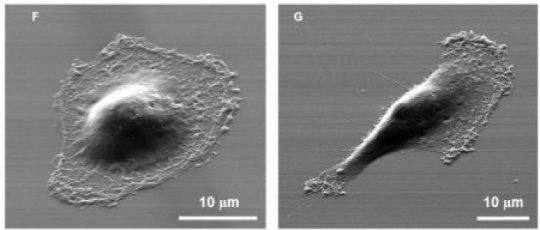

Why do some cancer cells break away from a tumor and travel to distant parts of the body? A team of oncologists and engineers from the University of Michigan teamed up to help understand this crucial question.
Cancer becomes deadly when it spreads, or metastasizes. Not all cells have the same ability to travel through the body, but researchers don’t understand why.
In a paper published in Scientific Reports, researchers describe a new device that is able to sort cells based on their ability to move. The researchers were then able to take the sorted cells that were highly mobile and begin to analyze them on a molecular level.
“People have used microfluidic devices before to look at the movement of cells, but the story typically ended there. We developed a device that separates the mobile cells and allows us to determine the gene expression of those highly mobile cells in comparison to the less mobile ones. By studying these differences in live cells, we hope to gain an understanding of what makes some cancer cells able to spread to other areas of the body,” says study co-lead author Steven G. Allen, an M.D.-Ph.D. student in the University of Michigan Medical School’s Medical Scientist Training Program.
The highly mobile cells are believed to be the more aggressive cells that cause metastases. By understanding how those cells tick, researchers believe they can develop targeted treatments to try to prevent metastasis.
“Using advanced micro-fabrication technologies, we can create micro-structures comparable to the size of cells. Living cells can then be manipulated on-chip at single-cell resolution. Using this technology, we can investigate the differences among individual cancer cells, while conventional approaches can study only the collective average behaviors,” says study co-lead author Yu-Chih Chen, a postdoctoral researcher in Electrical Engineering and Computer Science at the University of Michigan College of Engineering.
The differences in individual cancer cells are a key aspect of how cancer evolves, becomes resistant to current therapies or recurs.
“A primary tumor is not what kills patients. Metastases are what kill patients. Understanding which cells are likely to metastasize can help us direct more targeted therapies to patients,” says co-senior study author Sofia D. Merajver, M.D., Ph.D., scientific director of the breast oncology program at the University of Michigan Comprehensive Cancer Center.
The researchers believe this type of device might some day help doctors understand an individual patient’s cancer. Which cells in this patient’s tumor are really causing havoc? Is there a large population of aggressive cells? Are there specific markers or variants on those individual cells that could be targeted with treatment?
“This work demonstrates an elegant approach to the study of cancer cell metastasis by combining expertise in engineering and biology,” says study co-senior author Euisik Yoon, Ph.D., professor of electrical engineering and computer science and of biomedical engineering and director of the Lurie Nanofabrication Facility at the U-M College of Engineering.
“In past decades, engineers have developed biological tools with better resolution, higher sensitivity, selectivity and higher throughput,” Yoon adds. “However, without compelling applications, these engineering tools have little practical relevance. The goal of our lab is to develop tools that can be widely disseminated to the biology community to eventually impact clinical care for patients.”
In this work, extensive studies were performed on cell lines representing various types of cancer. The new device was designed to trace how cells move, sorting individual cells by their movement. It has a series of choke points that mimic the lymphatic systems in which cancer cells typically travel. Unlike other similar devices, in this case the captured and sorted cells can be harvested live for further study and analysis.
In a test using aggressive metastatic breast cancer cells, the researchers were able to sort the cells based on their motion, collect the sorted cells and send them through the device again. The cells maintained the same highly mobile characteristic upon repeated testing. The researchers also found that the more mobile cells had the characteristics and appearance under the microscope of metastatic cells and expressed significantly higher levels of markers associated with metastatic cancer.
“Understanding specific differences that lead some cancer cells to leave the primary tumor and seed metastases is of great benefit to develop and test anti-metastatic strategies,” Merajver says.
The device needs further testing and validation before it can begin to influence clinical care. Patients seeking more information about their options for cancer treatment can call the U-M Cancer AnswerLine at 800-865-1125.
Story Source:
The above story is based on materials provided by University of Michigan Health System. Note: Materials may be edited for content and length.
Journal Reference:
- Yu-Chih Chen, Steven G. Allen, Patrick N. Ingram, Ronald Buckanovich, Sofia D. Merajver, Euisik Yoon. Single-cell Migration Chip for Chemotaxis-based Microfluidic Selection of Heterogeneous Cell Populations. Scientific Reports, 2015; 5: 9980 DOI: 10.1038/srep09980
